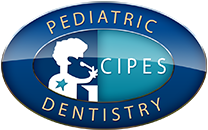You can do it Emmy! Learning to drink from a cup

Did you know that both the American Academy of Pediatric Dentistry (AAPD) and the American Academy of Pediatrics (AAP) recommend weaning your baby from the bottle by twelve months?
Many parents ask us how and when to transition from the bottle or breast to a cup. A good time to teach your baby to use a cup is between 6-9 months old or once you have started to introduce solid foods.
If you do this, by the time you start to wean your baby from the bottle your baby will already be comfortable drinking from a cup.
We recommend starting with either an uncovered cup or a cup with a straw rather than a sippy cup. Quite frankly, sippy cups were simply designed to keep your kitchen floors clean. The transition to a cup with a straw promotes more lip closure according to pediatric speech and language specialists. According to the AAP your goal should be that your child drink from an uncovered cup by age 24 months.
Start with water. A 6 to 12-month-old baby needs two to eight ounces of water per day on top of the water they get from breast milk/formula. Taking sips from a cup throughout the day will usually get them the water they need. And of course, water is less messy as they learn to drink from a cup.
By twelve months breast milk or formula will no longer be your child’s primary source of nutrition. At that age children can start drinking whole pasteurized cow’s milk, or continue breastfeeding if mother and baby prefer. As you transition from formula and to a cup don’t be too quick to offer juice or sweetened beverages. Remember that sweetened beverages can lead to cavities in children. Whole fruit is preferred rather than fruit juice, but if you do give your child juice limit it to no more than 4 oz. of 100% fruit juice a day. Don’t allow your child to “graze” with a sippy cup as that can contribute to obesity as well as cavities.
In addition, sippy cups send thousands of toddlers per year to emergency rooms annually, largely due to injuries suffered after falling with the lid in their mouths. This is still another reason why children shouldn’t walk around with the cup in their mouths.
Transitioning your baby from bottle to a cup can be challenging for you but for your baby who relishes new experiences and mastering things it can be fun!

